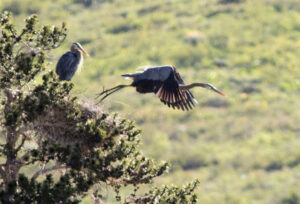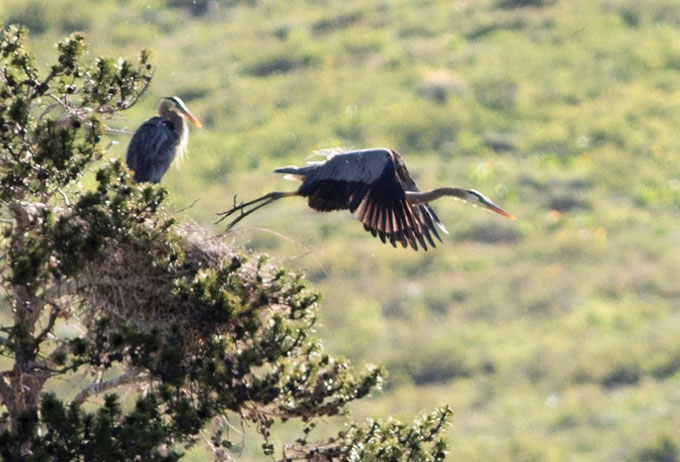By Chris Rourke
Along a more than four-mile stretch of the Slate River near the town of Crested Butte lies a colony of Great Blue Herons. They return every spring to lay eggs, hatch their brood and tend to chicks. The majestic and colorful creatures can be spotted high in the tree tops overlooking the river, with their blueish-grey plumage and long plumes fluttering in the breeze. Unfortunately, they too spot recreationists that use the waterway below—floaters as they’re called—the sight is simply too upsetting for them.
“What we’ve seen is a clear and dramatic pattern that proximity leads to a change in heron behavior from non-disturbance to disturbance,” said Western student Jake Bartholomew, who is working toward his M.S. in Ecology. He described the bird as exhibiting peaceful and slow movement prior to human presence. Then, as a floater enters the area, an alarmed reaction—and sometimes flushing—occurs.
“The Great Blue Heron reacts to human disturbance as if reacting to a predator,” he explained.
The conflict between man and beast is not new as recreationists push into prime wildlife habitat. On the Slate River, nearby homeowners want to see the Great Blue Heron thrive in their habitat, preserving the natural value of the landscape. Yet, floaters say they have few places they enjoy as much as the pristine Slate. They, too, want access to the intrinsic beauty of the area.
Working Group is Formed
Borne from the conflict, the Slate River Working Group was formed, aimed at finding some way the Great Blue Herons and floaters can co-exist. The group has spurred action through a volunteer effort to reduce traffic on the Slate. Signs kindly ask users to avoid the river March through mid-July, while the heron pairs raise their young.
But longer lasting solutions are being sought—ones that would make the Slate user friendly for all. The Crested Butte Land Trust has funded a four-year study on the herons, and invited Western Colorado University researchers to gather the information.
 Associate Professor of Wildlife & Conservation Biology Pat Magee and Bartholomew have been tapped to study how activity on the river impacts heron behavior and health. They’ve deployed a “heron cam” to observe such behavior in an unintrusive way. Such information is already shaping policy and will refine how the river is used in future generations.
Associate Professor of Wildlife & Conservation Biology Pat Magee and Bartholomew have been tapped to study how activity on the river impacts heron behavior and health. They’ve deployed a “heron cam” to observe such behavior in an unintrusive way. Such information is already shaping policy and will refine how the river is used in future generations.
“The process is really interesting—collaborative conservation and adaptive management,” said Magee. “The stakeholders are using data—in real time—to make decisions about how recreation is managed on the Slate River. Our data is helping inform decision making which is satisfying. Our data are limited and we only know so much, so there are many unanswered questions about the herons.”
No Compromise
The Great Blue Heron is an uncompromising creature, said Bartholomew. While humans have the ability of to adapt, herons do not. While they are not an endangered or threatened species, the Great Blue Heron is always “living at their extremes,” he said.
They’re constantly looking for food, endeavoring to perpetuate the lifecycle. Their daily tasks are “rigid,” and human activity has the ability to throw them off course in such a severe way it can lead to population decline.
Through the research that began in 2018, Bartholomew has intensely watched the birds that arrive in spring and begin to set up their summer homes. The birds likely pair up before they arrive at the colony, and once here, begin to build nests. Out of a ritual of affirming their partnership, the herons will share a dance with long twigs in their mouths, then weave them into their nest. Males who arrive unpaired build their own nests in an attempt to attract a mate.
Currently there are 12 pairs in the colony, said Bartholomew. He will work through the summer collecting data on their behavior in an attempt to find a way they can co-exist with floaters.
Unfortunately, what he has observed so far is herons don’t like humans and that leads to high cortisol levels in the bird.
“Our clear understanding is that having river recreation in close proximity to herons—immediately below their nests where the river flows—is disruptive to heron behavior and likely increases their risk of population decline,” added Magee. “Our sample sizes of observations of river users are small because we already implemented a voluntary no-float period which reduces the number of river floaters. That, combined with low flows that restrict floating, make it tough to observe numerous floaters.”
Is a Buffer Enough?
Bartholomew said that when the herons are provided a buffer zone of 300-400 meters, they feel more secure.
This likely is the last year of the study, and what he will attempt to determine is if there is a way that floaters can use the area without alarming the herons, such as low-profile paddle boarding and quiet zones.
“I’m hopeful through our study we may find a way to compromise with people so passionate about floating this beautiful stretch of river,” Bartholomew said. “Maybe from our evidence we can find a right way to float or at least a tactful way to float …. Once we collect data in a substantial way and relate it to how the herons respond, we’ll be able to see certain trends if there are. But … I don’t know. It could be absence versus presence.”
Chris Rourke is the University Communications Officer for Western Colorado University and loves to tell stories about all things Western.


